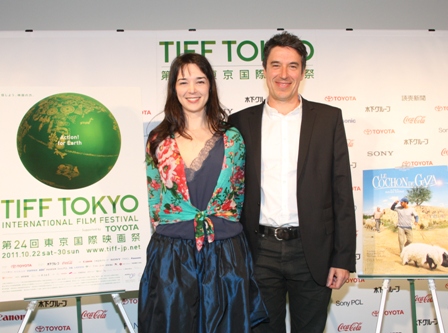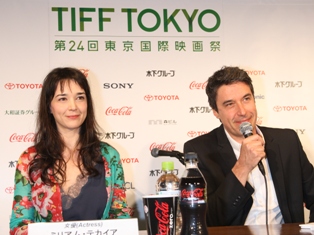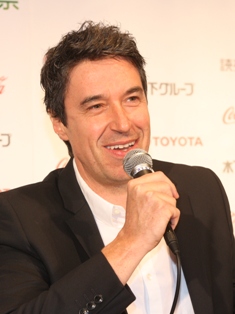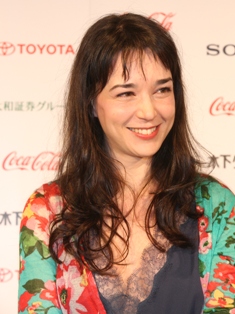A press conference featuring When Pigs Have Wings from the Competition section was held today as follows:
■ Date & Time October 29th (Saturday), from 15:00 @Movie Café
■ Appearance Sylvain Estibal (Director/Screeplay), Myriam Tekaїa (Actress)

Here are some notes and quotes:
Myriam Tekaїa (MT): I hope you are not disappointed that I am here instead of the pig! Tokyo is very amazing and I am honored to be here.
Sylvain Estibal (SE): Konnichiwa! Tokyo is a great city with a lot of excitement and happiness. It is a special place with many small worlds living side by side.

Q: Where did you get the idea to use a pig as the protagonist? Also, what has become of the black pig in the movie?
SE: The idea came to me one night in a hotel. My plan was not to make a movie about the conflict in the Middle East but I thought that to find a link between the two communities could be the pig. The pig is rejected by both communities and I thought this could be a funny link of peace between them. As for the black pig, we ate it!!(laugh). No, it is in the countryside in the south of France living in the foot of the Pyrenees.
Q: Why did you use fantasy in the last scene?
SE: The reason I used fantasy was because although there is comedy, the subject is so sad and strong. So I would have to end the story with a nice image—a symbolic image of what could be peace for both sides. Also, when I went to the West Bank, I saw two people facing each other, both hurt. So I wanted to symbolize this by having two people do something together as a token of peace, which in my movie’s case was to dance together.

Q: Living in Uruguay and being a journalist. Has this experience led you to shoot a movie set in the Middle East?
SE: I have been to the West Bank so things I saw there are in the movie, for instance, the military checkpoint and the Palestinian family living on the roof of a building. I have done a project in this area which was to give cameras to one Jewish family and one Palestinian family. I had them use it for one year to take pictures of their daily lives.
After a year, they exchanged the photos they took during that year. This was a way to change their view of each other, the ‘enemy’ and for them to have peace through a small project like that.
Q: How was it playing the role of a Jewish person although you are from Tunisia?
MT: It was not as a Tunisian that I apprehended the role of Yelena. In the beginning, it was not as a Jewish person that I saw Yelena so I really had to work on her and struggle about. But this is what we do as actors—when you accept a role you have to embody everything that constructs and explains the character and justify everything about her.

Q: The Palestine-Jew issue has often been used in films but what new angle did you employ in your film?
SE: I wanted to give a fresh and new vision of the conflict. My concern was to bring out each side of the issue, not just one side. Also, I wanted each side to like the movie, even though they might reject one side. It was important that I convey that they are both victims of the situation. You see, in reality, people’s lives in this region are not about politics but about their daily lives who try to pursue a normal life. In other words, common people just want to live normally and I wanted to put the conflict at that level—a normal life.
MT: Let me add that this is a comical story of the outrage and the absurdity of the conflict.
Q: Did you shoot in the Gaza District or in Jerusalem?
SE: My first idea was to shoot in Gaza, but it was impossible to get permission, plus, we had to use pigs, not only one but five! So we shot in Malta because the landscape had similar characteristics as the West Bank. Of course I wanted to shoot in the West Bank so I was shocked that we couldn’t. Actually, we also went to Germany to shoot the inside of Jafaar’s house. So when he enters his house he goes in from Malta and when he comes out, it’s from Germany!












